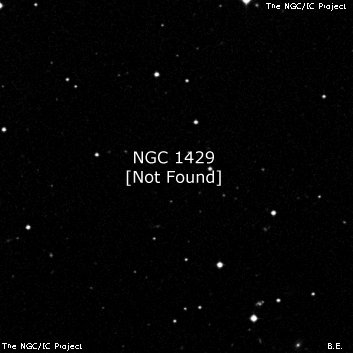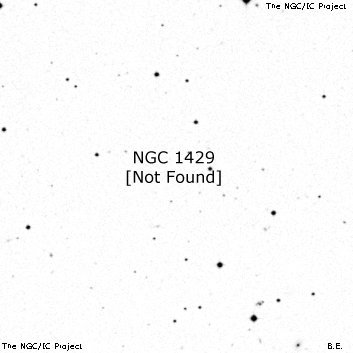NGC/IC Project Restoration Effort
(This is a very very beta version)
NGC1429


Basic Information
Location and Magnitude
Right Ascension: 3:44:4.1
Declination: -4:43:5
Constellation: ERI
Visual Magnitude:
Historic Information
Discoverer: Leavenworth
Year of discovery: 1886
Discovery aperture: 26.3
Observational
Summary description: eF, vS, E 0°, gbMN, f of 2
Sub-type: NF
Corwin's Notes
=====
NGC 1429 is lost. Leavenworth describes it as "15.5, 0.3 x 0.2, E 180 deg,
gbMN; 2nd of 2." The first of two is NGC 1424 which carries this description
in the Leander McCormick list: "15.2, 0.2, R, gbM; 1st of 2, one of which is
GC 763 [N1424]; * 10 p 15 sec."
The description of Leavenworth's "2nd of 2" matches the one galaxy in the
area. But that is it. The star 15 sec west of the galaxy is 13th magnitude,
and there is an 11th magnitude star half that distance northwest. Why did
Leavenworth not mention that? I think that Leavenworth has misidentified the
known galaxy so that his description applies to a different pair altogether.
But which pair? I don't see any other in the area that matches the
descriptions. Wolfgang chose a star near Leavenworth's position, but that
clearly does not match the description, particularly, "E 180 deg, gbMN".
So, NGC 1429 is another lost NGC object until someone with sharper eyes than
mine has a go at the problem.
-----
Yann Pothier has suggested that Leavenworth has confused his description of
the field. Here is a paraphrase of what Yann had to say in an email in April
2016:
I wonder if Leavenworth's description of the field is confused -- perhaps he
saw three objects but described only two that he believed to be
uncatalogued. His first object matches NGC 1418 quite well as the field
shows a magnitude 11 star 16 seconds west (close to NGC 1417 = GC 758; his
crude position estimate led him to believe it was NGC 1424 = GC 763) and
seems quite round. His second object would then indeed be NGC 1424 (the
position offsets would be 78 seconds west and 50 seconds west for the two
galaxies); he would have thought it was new, misled by his poor position.
This might be what happened, but Leavenworth's note about the "* 10 p 15 sec"
is difficult to reconcile with the sky -- the star is one arcminute southeast
of the brighter galaxy. Surely it would make be far more appropriate to write
the note that way than the way he did.
In the end, I think it is worth keeping Yann's note in mind, so I have added
the appropriate designations to the position table -- with plenty of question
marks, of course.



